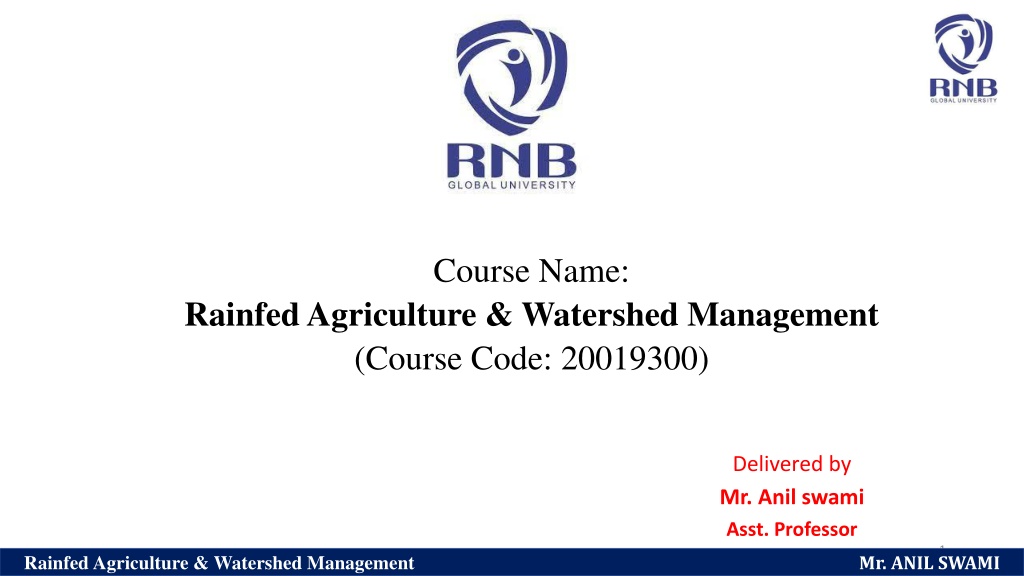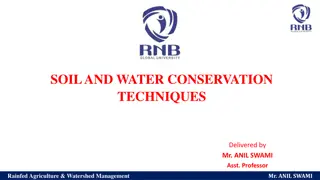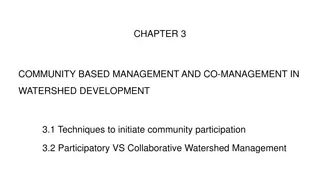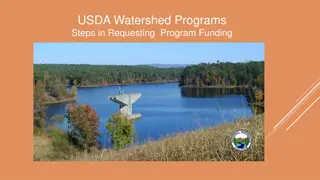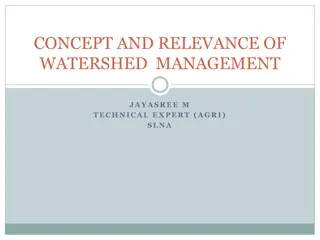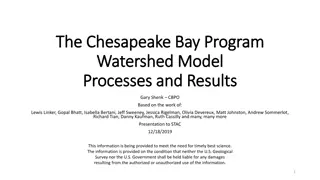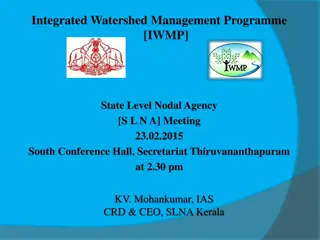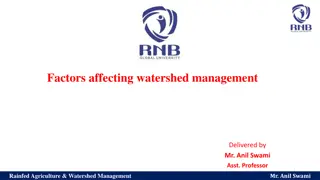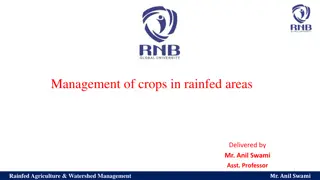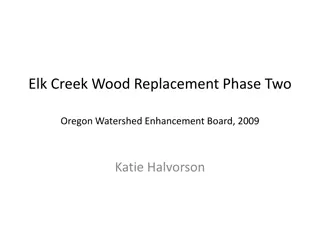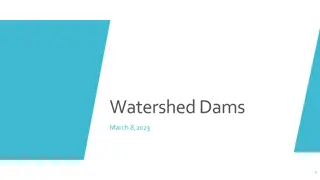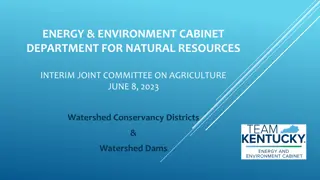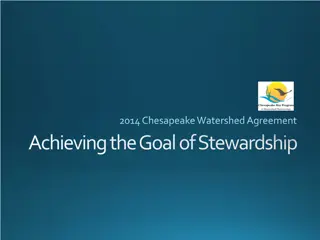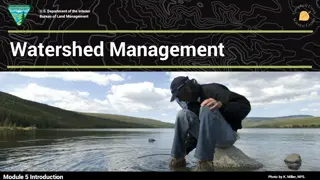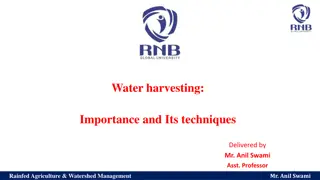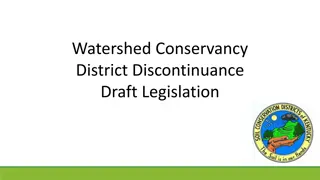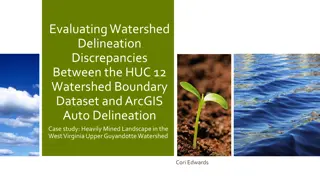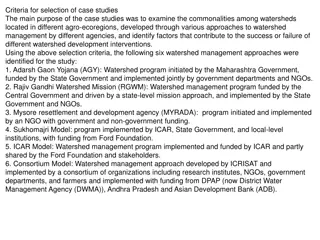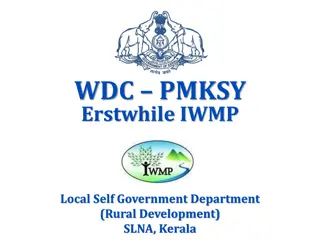Rainfed Agriculture & Watershed Management Course Overview
This course on Rainfed Agriculture & Watershed Management, delivered by Mr. Anil Swami, covers topics such as soil and climatic conditions in rainfed areas, water harvesting techniques, contingent crop planning, seasonal rainfall analysis, and soil conservation practices. It emphasizes the significance of dryland agriculture in meeting future food needs and discusses different types of rainfed agriculture. The course outlines the challenges and strategies for cultivating crops under rainfed conditions, including dry farming and dryland farming. Join to enhance your understanding of sustainable agricultural practices in rainfed regions.
Download Presentation

Please find below an Image/Link to download the presentation.
The content on the website is provided AS IS for your information and personal use only. It may not be sold, licensed, or shared on other websites without obtaining consent from the author. Download presentation by click this link. If you encounter any issues during the download, it is possible that the publisher has removed the file from their server.
E N D
Presentation Transcript
Course Name: Rainfed Agriculture & Watershed Management (Course Code: 20019300) Delivered by Mr. Anil swami Asst. Professor 1 Mr. ANIL SWAMI Rainfed Agriculture & Watershed Management
Objective:- Tell the soil and climatic conditions prevalent in rainfed areas. Interpret various water harvesting techniques and their efficient utilization. Apply contingent crop planning for aberrant weather conditions. Examine the seasonal rainfall and different types of watershed and its components. Select soil and water conservation techniques to avoid their losses. 2
Topics to be covered Rainfed Agriculture Introduction, Types and History of Rainfed Agriculture in India 3 Mr. ANIL SWAMI Rainfed Agriculture & Watershed Management
Introduction Even after the utilization of all our water resources for irrigation, about half of the cultivated area will remain rainfed. As there is hardly any scope for increasing the area under cultivation, it is really a colossal task for meeting the future food needs. It is against this background that the role of dryland agriculture gained importance. Agriculture is the single largest livelihood sources in India with nearly two thirds of people depend on it. 4 Mr. ANIL SWAMI Rainfed Agriculture & Watershed Management
Rainfed agriculture is as old as agriculture itself. Growing of crops entirely under rainfed conditions is known as dryland agriculture. Very often, the words dry farming, dryland agriculture and rainfed agriculture are used like to indicate similar farming situation. Clearly, the two exclude irrigations. Depending on the amount of rainfall received, it can be grouped into three categories: 5 Mr. ANIL SWAMI Rainfed Agriculture & Watershed Management
Types of Dryland/Rainfed Agriculture Definitions i. Dry farming: is cultivation of crops in regions with annual rainfall less than 750 mm. Crop failures is most common due to prolonged dry spells during the crop period. These are arid regions with a growing season (period of adequate soil moisture) less than 75 days. Moisture conservation practices are necessary for crop production. 6 Mr. ANIL SWAMI Rainfed Agriculture & Watershed Management
ii. Dryland farming: is cultivation of crops in regions with annual rainfall more than 750 mm. In spite of prolonged dry spells crop failure is relatively less frequent. These are semi-arid tracts with a growing period between 75 and 120 days. Moisture conservation practices are necessary for crop production. However, adequate drainage is required especially for vertisols or black soils. Rainfed Agriculture & Watershed Management 7 Mr. ANIL SWAMI
iii. Rainfed farming: is crop production in regions with annual rainfall more than 1150 mm. Crops are not subjected to soil moisture stress during the crop period. Emphasis is often on disposal of excess water. These are humid regions with growing period more than 120 days. 8 Mr. ANIL SWAMI Rainfed Agriculture & Watershed Management
In dry farming and dryland farming, emphasis is on soil and water conservation, sustainable crop yields and limited fertilizer use according to soil moisture availability. In rainfed agriculture, emphasis is on disposal of excess water, maximum crop yield, high levels of inputs and control of water erosion. 9 Mr. ANIL SWAMI Rainfed Agriculture & Watershed Management
Particular Dry Farming Dryland Farming Rainfed farming Sr. No. 1 Rainfall/annum (mm) < 750 750 1150 > 1150 2 Moisture availability Acute shortage Shortage Enough 3 Crop growing season < 75 days 75 120 days > 120 days 4 Growing region Arid Semi-arid Humid 5 Cropping systems Single crop/ intercropping Single crop/ intercropping Inter/ Multi- cropping 6 Dry spells Most common Less frequent No occurrence 7 Crop failure More frequent Less frequent Rare 8 Constraints Wind erosion Wind erosion/ water Water erosion erosion 9 Measures Required Moisture conservation Moisture conservation Proper drainage practices practices & drainage for required vertisols 10 Mr. ANIL SWAMI Rainfed Agriculture & Watershed Management
The Concept: The concept of rainfed agriculture (farming) under which both dry farming and dryland farming (dryland agriculture) is included has been changed. Dry farming was the earlier concept for which amount of rainfall (less than 500 mm annually) remained the deciding factor for more than 60 years. In modem concept, dryland areas are those where the balance of moisture is always deficit side. In other words, annual evapotranspiration exceeds precipitation. 11 Mr. ANIL SWAMI Rainfed Agriculture & Watershed Management
Deficit in moisture is bound to affect the crop production under dryland situation, ultimately resulting into total or partial failure of crops. Accordingly, production is either low or extremely uncertain and unstable which are the real problems of dryland in India. Success of crop production in these areas depends on the amount and distribution of rainfall, as these influences the stored soil moisture and moisture used by crops. 12 Mr. ANIL SWAMI Rainfed Agriculture & Watershed Management
Amount of water used by crop and stored in soil is governed by water balance equation: ?? = ? (? + ?) When balance of the equation shifts towards right, precipitation (P) is higher than ET, so that there may be water logging or it may even lead to runoff (R) and flooding. On the other hand, if the balance shifts to left, ET becomes higher than precipitation, resulting in drought. 13 Mr. ANIL SWAMI Rainfed Agriculture & Watershed Management
History of Rainfed Agriculture in India First systematic scientific approach to tackle the problems of dry farming areas was initiated by Tamhane in 1923 on a small plot at Manjri Farm near Pune and the work passed on to kanitkar in 1926. A comprehensive scheme of research was drawn up by Kanitkar with financial support from the ICAR. Realizing the importance, the 1CAR launched a comprehensive project on dryland farming at five centers: Sholapur and Bijapur in 1933, Hagari and Raichur in 1934 and Rohtak in 1935. 14 Mr. ANIL SWAMI Rainfed Agriculture & Watershed Management
A decade of work up to 1943-44 mainly on rainfall analysis, physico-chemical properties of soils, physiological studies on millets and on agronomic aspects resulted in a series of dry farming practices commonly known as the Bombay dry farming practices, Hyderabad dry farming practices and Madras dry farming practices. These practices stressed the need for contour bunding, deep ploughing, and application of FYM, low seed rate with wide spacing, mixed cropping and crop rotation. These recommendations could not motivate the farmers to adopt them as the yield advantage was about 15-20 per cent over a base yield of 200-400 kg/ ha. 15 Mr. ANIL SWAMI Rainfed Agriculture & Watershed Management
By the mid-1950s, importance of soil management (soil and moisture conservation) was realized for improving the productivity of dryland and the ICAR established eight Soil Conservation Research Centers in 1954. However, yield improvement was not more than 15-20 per cent over the basic yield of 200-400 kg/ha. Importance of short duration cultivars maturing within adequate soil moisture available period (crop growing period) was recognized during 1960s. 16 Mr. ANIL SWAMI Rainfed Agriculture & Watershed Management
The place of high yielding varieties and hybrids for yield advantage in dryland agriculture was realized in mid-1960s. With the establishment of All India Coordinated Research Project for Dryland Agriculture (AICRPDA) in 1970, emphasis was shifted to multi-disciplinary approach to tackle the problem from several angles. Similar efforts were initiated at ICR1SAT, Hyderabad in 1972. The ICAR selected 25 dryland agricultural centers all over the country on the basis of the moisture deficit, soil type and rainfall characteristics. Rainfed Agriculture & Watershed Management 17 Mr. ANIL SWAMI
The chronology of major events in dryland agricultural research in India is as follows: 1880 The First Famine Commission was appointed by the then British Empire to suggest ways and means to offset the adverse effects of recurring droughts, which country faced from 1860 onwards. An important recommendation of the commission was to set up protective irrigation project. 1920 The Royal Commission on Agriculture stressed the need for scarcity tract development. 1923 Imperial Council of Agricultural Research sanctioned six schemes and established the first Dryland Research Station at Manjari (Pune) by Tamhane. 18 Mr. ANIL SWAMI Rainfed Agriculture & Watershed Management
1953 Establishing Central Soil Conservation Board. 1954 The Central Soil and Water Conservation Research and Training Institute at Dehradun. 1959 Central Arid Zone Research Institute (CAZRI) was established at Jodhpur to tackle the problems of arid agro-ecosystem. 19 Mr. ANIL SWAMI Rainfed Agriculture & Watershed Management
1970 All India Coordinated Research Project for Dryland Agriculture (AICRPDA) in 23 locations (now 25) with the support from Canadian International Development Agency through an instrument of bilateral collaboration signed between the Governments of India and Canada (up to 1987). 1972 The Consultative Group on International Agricultural Research (CGIAR) established the International Crops Research Institute for the Semi- Arid Tropics (ICRISAT) at Hyderabad 20 Mr. ANIL SWAMI Rainfed Agriculture & Watershed Management
1985 The Central Research Institute for Dryland Agriculture (CRIDA) at Hyderabad 1970 The ICAR collaborated with Canadian dryland research to (Indo-Canadian Dryland Research, from 1970 to 1987. 1987 21 Mr. ANIL SWAMI Rainfed Agriculture & Watershed Management
22 Mr. ANIL SWAMI Rainfed Agriculture & Watershed Management
